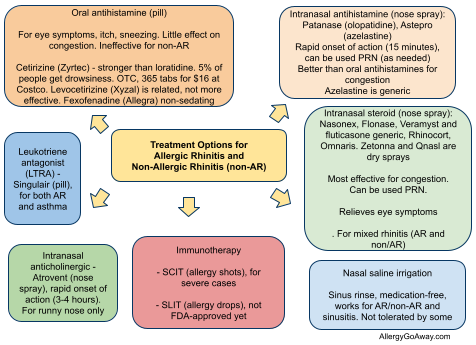 Allergic rhinitis (AR) and nonallergic rhinitis (NAR) may present with different clinical and laboratory characteristics. This Italian study included 1,500 adult patients, aged 18-81 years, diagnosed with rhinitis who underwent allergic evaluation including:
Allergic rhinitis (AR) and nonallergic rhinitis (NAR) may present with different clinical and laboratory characteristics. This Italian study included 1,500 adult patients, aged 18-81 years, diagnosed with rhinitis who underwent allergic evaluation including:- skin prick test
- blood eosinophil counts
- nasal eosinophil counts
- peak nasal inspiratory flow (PNIF) measurement
- evaluation of nasal symptoms using a visual analog scale (VAS)
73% of the patients diagnosed with rhinitis had allergic rhinitis (AR). A higher nasal eosinophils count was associated with AR and a lack of clinical response to antihistamines.
Patients with NAR were older and predominantly female.
AR patients had more sneezing and nasal pruritus, whereas NAR was characterized mainly by nasal obstruction and rhinorrhea.
AR patients had more severe symptoms and recurrent conjunctivitis, whereas NAR patients had more frequent episodes of recurring headaches as well as olfactory dysfunction (problems with the ability to detect smells).
PNIF, blood eosinophil counts and VAS of nasal symptoms were higher in patients with AR.
Several variables were statistically different between AR and NAR:
- clinical response to antihistamines, OR 22.59
- conjunctivitis, OR 4.49
- sneezing, OR 4.09
- nasal pruritus, OR 3.84
- intermittent/severe nasal symptoms, OR 3.66
- mild symptoms, OR 0.21
Several clinical and laboratory parameters may help to exclude the diagnosis of AR.
What symptom works best for diagnosis of allergic rhinitis? The answer has been the same for years: eye itching (http://goo.gl/koioJ).

Treatment Options for Allergic Rhinitis and Non-Allergic Rhinitis (click to enlarge the image).
References:
Differences and Similarities between Allergic and Nonallergic Rhinitis in a Large Sample of Adult Patients with Rhinitis Symptoms. Di Lorenzo G, Pacor ML, Amodio E, Leto-Barone MS, La Piana S, D'Alcamo A, Ditta V, Martinelli N, Di Bona D. Int Arch Allergy Immunol. 2011 Feb 2;155(3):263-270.
Analysis of a database to predict the result of allergy testing American Journal of Rhinology & Allergy, Volume 28, Number 5, September/October 2014, pp. 414-418(5) http://bit.ly/1udyzC8
Nonallergic rhinitis, CCJM 2012 review.
Image source: Wikipedia, a Creative Commons license.
73% of the patients diagnosed with rhinitis had allergic rhinitis (AR). A higher nasal eosinophils count was associated with AR and a lack of clinical response to antihistamines.
Patients with NAR were older and predominantly female.
AR patients had more sneezing and nasal pruritus, whereas NAR was characterized mainly by nasal obstruction and rhinorrhea.
AR patients had more severe symptoms and recurrent conjunctivitis, whereas NAR patients had more frequent episodes of recurring headaches as well as olfactory dysfunction (problems with the ability to detect smells).
PNIF, blood eosinophil counts and VAS of nasal symptoms were higher in patients with AR.
Several variables were statistically different between AR and NAR:
- clinical response to antihistamines, OR 22.59
- conjunctivitis, OR 4.49
- sneezing, OR 4.09
- nasal pruritus, OR 3.84
- intermittent/severe nasal symptoms, OR 3.66
- mild symptoms, OR 0.21
Several clinical and laboratory parameters may help to exclude the diagnosis of AR.
What symptom works best for diagnosis of allergic rhinitis? The answer has been the same for years: eye itching (http://goo.gl/koioJ).
Treatment Options for Allergic Rhinitis and Non-Allergic Rhinitis (click to enlarge the image).
References:
Differences and Similarities between Allergic and Nonallergic Rhinitis in a Large Sample of Adult Patients with Rhinitis Symptoms. Di Lorenzo G, Pacor ML, Amodio E, Leto-Barone MS, La Piana S, D'Alcamo A, Ditta V, Martinelli N, Di Bona D. Int Arch Allergy Immunol. 2011 Feb 2;155(3):263-270.
Analysis of a database to predict the result of allergy testing American Journal of Rhinology & Allergy, Volume 28, Number 5, September/October 2014, pp. 414-418(5) http://bit.ly/1udyzC8
Nonallergic rhinitis, CCJM 2012 review.
Image source: Wikipedia, a Creative Commons license.